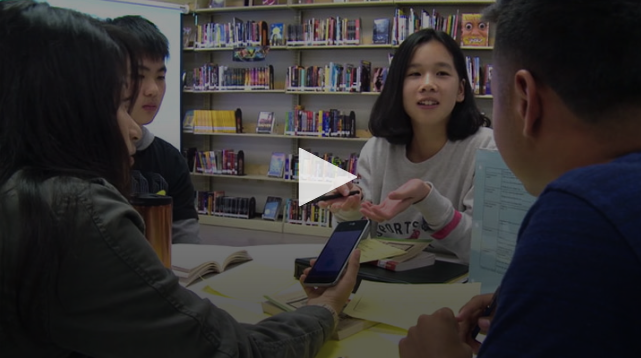Group work.
Two seemingly innocent words that cause both teachers and students alike to tremble with apprehension. The ghosts of bad group work past conjure haunting memories of disagreements, distractions, and indifference. Yet, as educators we know student-to-student interaction is a crucial component in increasing both engagement and academic language development.
So, how do we avoid the pitfalls of bad group work and foster an environment of stimulating discussion and student collaboration?
Mix It Up & Observe
Creating student groups is an important task that requires the careful consideration of many factors, but especially student dispositions. At the beginning of the year, teachers should be strategic about devising opportunities for students to work with as many different partners and small groups as possible so they can observe which grouping configurations are going to be the most productive.

VIDEO: Lit Circles: Fostering Heterogenous Collaboration
Corner Partners is an imaginative way to provide students ample opportunities to interact with a variety of their peers. Language and Literacy SIOP Trainers Kellie Bugajski and Maura Sedgemen have adapted one of Vogt and Echevarria’s SIOP strategies to develop this interactive activity for pairing up students.
- To begin, students are asked one of four teacher-prepared “either-or” questions, such as: Do you prefer winter or summer?
- Based on their answers, students are then directed to go to specific corners of the classroom.
- Once at their designated corner, the students are asked to introduce themselves to someone new and discuss the reasoning for their answers.
- After they’ve finished talking about their answer choices with each other, the students write their partners’ names on the recording sheet their teacher has prepared. These new partners can then be used for future classroom groupings.
- The process continues until students have answered and discussed all four questions.
While students are working with different partners, pay special attention to their individual personalities and the needs they have to feel comfortable actively participating in a group.
- For example, look to see which students are patient and might be good at working with students with limited English proficiency, who may need extra wait time to process the language.
- It’s also helpful to take note of which classmates the more reserved students open up to and which overpower them during discussions.
- Finally, study the student interactions to identify potential leaders that have demonstrated skill at coordinating and guiding the work of their peers.
Troubleshoot Potential Problems
Another essential strategy for ensuring harmonious and constructive student collaboration is to troubleshoot potential problems by establishing student-generated working agreements prior to diving into a group project or assignment. In order to create high-quality working agreements, I lead my students through the following brainstorming activity:
- Begin by having students divide a blank sheet of paper in thirds and label each section with the following headings: benefits, problems, and solutions.
- After the students have their papers set up, ask them to make a list of the benefits of working with a group and record their answers in the first column. Students should work on their lists individually at first, but then add to their ideas through small-group and eventually whole-class discussion.
- Next, ask the students to make a list of potential problems of working in a group and record their ideas in the middle column. Remember to ask students to share out their ideas as a class, so everyone will have a well-developed list of potential problems they might encounter while working within a group.
- Finally, ask the students to review the list of problems and recommend a solution for each problem they’ve identified. For example, if students have pointed out that sometimes group members argue about the right answer, a solution might be to vote or get an outside opinion when group members cannot agree on a response.
Now that students have a thorough list of potential problems and solutions of working in groups, they’re ready to draft a list of working agreements. Make sure to remember to change around the student groupings, so the students are interacting with different partners than they did for the brainstorming activity. Doing so will maximize the students’ exposure to different viewpoints. After the students have had the chance to discuss their ideas with their new small group or partner, they can share and consolidate ideas to create a class set of small group working agreements to be posted in the classroom.

VIDEO: Group Contracts for Collaborative Work
Design for Success
Equally important to developing student work agreements is being strategic in the way you design group projects or assignments in the classroom. The choices teachers make when crafting a group activity can either lead to cooperation or chaos.
There are four key factors to keep in mind while planning a group assignment.
1 – Shared Leadership
In every group, there are students who will naturally step up to take the lead and students who will quietly sit back hoping that nobody will notice if they don’t say anything. This can be especially true of English learners who may lack the confidence to speak up during discussions. Yet, practice in leading a group and justifying your thinking is important for all students, particularly our English language learners who need practice speaking the new language they’re learning.
When designing a group activity, teachers should make sure that every member of the group has a meaningful role that requires him or her to take the lead on at least one part of the group assignment. For example, in my English Language Arts class, I have my students work in groups of three to review and discuss the chapters of the novel they’re reading. In these groups, the students are required to complete a vocabulary log, write a chapter summary, and generate discussion questions. Each of the students in the group is required to be the discussion leader for one of the activities.
2 – Evenly Distributed Workload
Another important consideration in planning a group assignment is to ensure that every student is required to contribute equally to the final product. For example, when asking a group to write discussion questions about a text they’ve read, you’d want to make sure that the number of questions you require the group to write corresponds to the number of members in the group. Additionally, if you asked students to work together to answer a set of questions, you’d want to ensure there are enough questions to be equally distributed amongst all the members of the group. You can require students to initial the ideas they shared or the questions they took the lead on answering to verify that every group member has had equal input on the assignment. Setting the expectation that every student has to participate equally prevents the more confident students from taking over and ignoring the ideas of the other members of the group.
3 – Clearly Defined Protocols
One of the greatest obstacles students experience when working collaboratively is not knowing how to get started and trying to figure out a logical order to accomplish the tasks they’ve been assigned. Our vast experiences of having worked in teams as adults make us forget that collaboration is a skill we’ve developed over time. We forget the importance of laying out some protocols for our students and giving them some guidance on how to organize their work and discussions.
For instance, in the cooperative learning structures Dr. Spencer Kagan designed, group members are assigned letters of the alphabet: A, B, C, D. These letters are used to help the students determine who will begin the discussion and the order in which the conversation will proceed. It’s also important to establish some guidelines for active listening, such as looking and leaning into the person that is speaking, asking clarifying questions, and giving a verbal acknowledgment of what the speaker has said.
4 – Intentional Grouping
The final element teachers should remember when planning and designing collaborative assignments is the grouping of students. When assigning students to groups, there are several aspects I reflect on to enhance the collaborative experience for my students.
- Group Size: I limit my small group size to 3-4 students. It’s a small enough working environment for all students to have plenty of opportunities to share their thinking, but large enough so that if one of the members of the group is absent it won’t result in students being left without partners.
- Student Dispositions: As I mentioned earlier, I spend a great deal of time at the beginning of the year observing how my students interact with each other. My goal is to be able to use this information to form groups that balance out their personalities. For example, if some students tend to rush through assignments and skip over important details, I partner them with those who are more deliberate and take their time to attend to all the specifics of an assignment. Also, when I have students who are talkative and easily distracted, I pair them with students who are focused and aren’t afraid to redirect peers when they get off task.
- Language Proficiency: I also consider the language proficiency of my English language learners when creating groups. It can be frustrating and overwhelming for students with limited English proficiency if they’re partnered with those with very advanced literacy skills. Newcomers need an environment where they can feel comfortable experimenting with the language and making mistakes. Another idea is to place two students who share a common native language in the same group, so newcomers can use their first language to ask questions and clarify confusing information. Keep in mind though, that not all members should share the same language, so communicating in English will still be a necessity for completing the assignment.
- Literacy Strengths: The final consideration when assigning students to groups is the students’ capabilities in the four language domains: reading, writing, speaking, and listening. While it’s important for English language learners to be placed with students who will boost their confidence and encourage them to participate, it’s equally important that they interact with native speakers who can provide sound models of the English literacy skills they’re acquiring. When forming collaborative teams in the classroom, make sure each group has at least one member who can display the appropriate reading, writing, and speaking skills necessary for the successful completion of the assignment.
Teach the Talk
One last strategy that’s influential in generating effective collaboration is coaching students on how to conduct academic conversations. This is especially true of English language learners who may lack the experience and practice to perform all of the language functions needed to fully participate in a discussion.
Language functions are the purposes in which we use language to communicate, such as clarifying, adding, or justifying ideas. Since every language function has its own unique grammatical structure and vocabulary, we must explicitly teach these types of phrasings to our students. One way for teachers to scaffold these communication skills is by providing a bookmark or table topper with a couple of sentence frames for each purpose the students will be using language for during their group discussions.
These sanity-saving strategies help me to keep my students focused, courteous, and engaged when collaborating together on a group assignment — and I hope they’ll help you, too. Yet as an educator, I’m constantly searching for ways to continue improving the small group work in my classroom. I know that the next great idea is always just around the corner, so I’d love to hear from you about your thoughts and suggestions on this topic!






